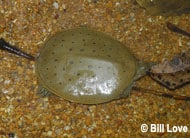Description:
Spiny softshells also grow to large size as adults, thus consideration of their eventual needs should be taken into account before acquiring one. Maintaining good water quality is key to keeping healthy softshell turtles. Sand substrates should be provided so that spiny softshells can bury themselves, yet reach the surface to breathe using their long neck. Filtration is essential, although bottom filters may be quickly clogged with sand. Basking sites can be constructed from plastic egg crates, as these can be placed at a slanting angle into the water and allow the turtle to choose whether to emerge completely from the water or bask partially submerged. A basking light that provides warmth, of at least 80 degrees Fahrenheit as well as multi-spectrum lighting, is also important. In the wild, spiny softshells often bask on sandbars within inches of the water’s edge. Spiny softshells, like other softshells, may injure each other when kept together or with other species of turtles.
Habitat:
The spiny softshell is primarily a riverine species. It is more of a habitat generalist than the smooth softshell and does occur in rocky streams as well as sandy-bottomed river systems.
Range:
The spiny softshell has a wide range and occurs in rivers and streams of the Mississippi, Missouri and Ohio drainages. It also occurs in Atlantic drainages in the Southeast, ranging through Georgia and the Carolinas. In the northeast it occurs in the St. Lawrence drainage, and in the west it occurs in Montana. In the Southwest it occurs in the Rio Grande drainage.
Scientific Name: Apalone spinifera
Species Group: turtle
Family: Trionychidae
Size: Adult female spiny softshells can reach 18 inches or more, while males are usually no more than 10 inches.
Level: intermediate
Weight: N/A
Dangerous: No



